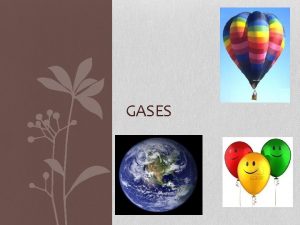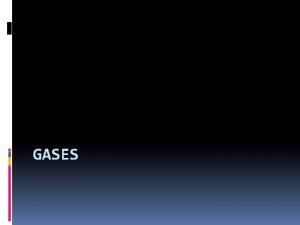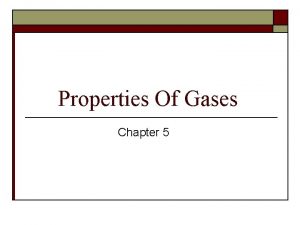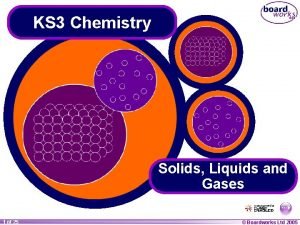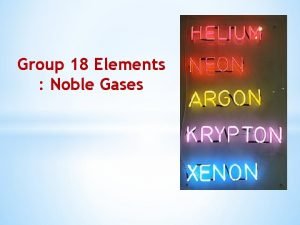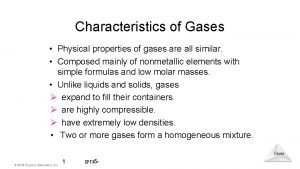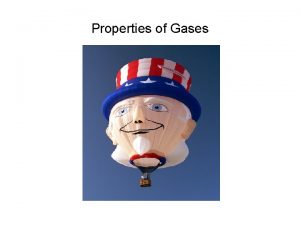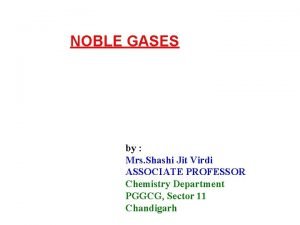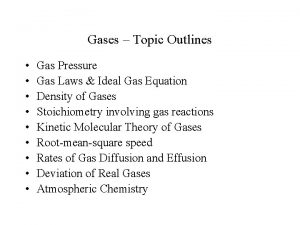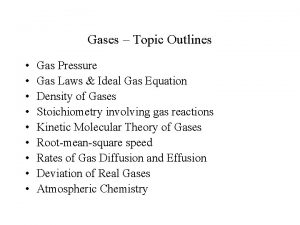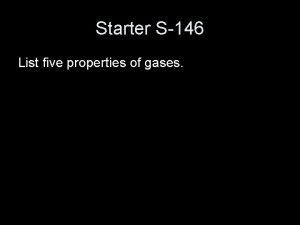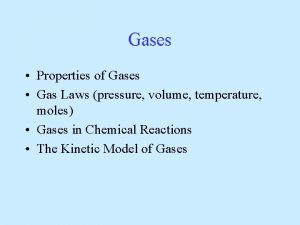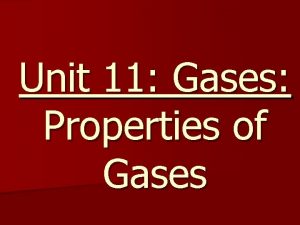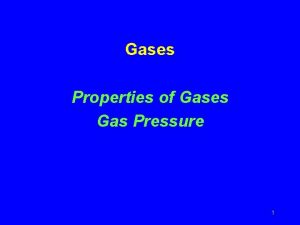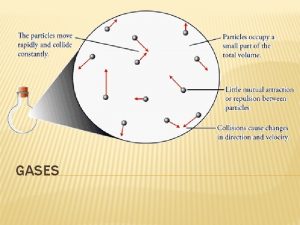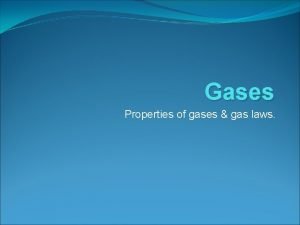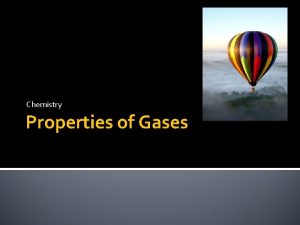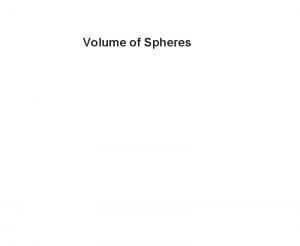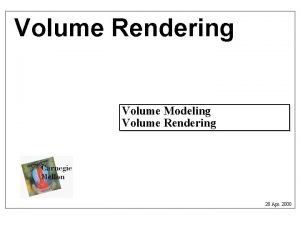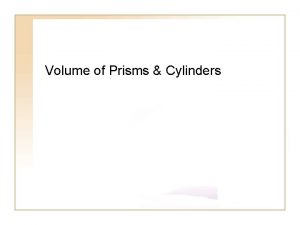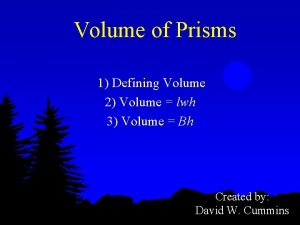Gases Properties of Gases Gases adopt the volume





































- Slides: 37

Gases

Properties of Gases • Gases adopt the volume and shape of their containers • Gases are easy compressed, whereas liquids and solids are not • Gases placed within the same container mix uniformly and completely • Gases have much lower densities than liquids and solids

Pressure • Gas molecules exert a pressure when they hit the surface of their container • Unit of pressure: • Atmospheric pressure (1 atm): 1 atm = 101 325 Pa = 1. 01325 x 102 k. Pa

Atmospheric Pressure • Atmospheric pressure is the pressure exerted by the column of air situated above a surface • We do not feel the atmospheric pressure because we are physiologically adapted for it

Atmospheric Pressure • We measure atmospheric pressure with a barometer • The mercury column exerts a pressure equal to the atmospheric pressure: 1 atm = 760 mm Hg = 760 torr

Gas Pressure • Gas pressure is measured using a manometer • We use Hg since it is very dense (13. 6 g/m. L) and permits the manufacturing of compact barometers and manometers, if not 1 atm = 760 mm x 13. 6 = 10 300 mm H 2 O = 10. 3 m H 2 O!!!

Boyle’s Law • Boyle observed that the volume of a gas decreases (increases) when the pressure exerted on the gas increases (decreases) • Boyle’s Law states that the volume of a given mass of gas at constant temperature is inversely proportional to its pressure

Boyle’s Law • At constant temperature:

Charles’ and Gay-Lussac’s Law • Charles and Gay-Lussac observed that at constant pressure for a given mass of gas, the volume increases with increasing temperature and decreases with decreasing temperature

The Kelvin Scale • Plots of V vs. T have different slopes for different pressures, but the extrapolation of each line to V = 0 crosses the T axis at T = -273. 15 o. C • Kelvin proposed that -273. 15 o. C is the lowest temperature that can be achieved, i. e. , the absolute zero • The Kelvin Scale: T(K) = t(o. C) + 273. 15 o. C

Charles’ and Gay-Lussac’s Law • N. B. These formulas are only valid if we express T in kelvins!!!

Avogadro’s Law • Avogadro’s hypothesis (1811): At the same temperature and same pressure, equal volumes of different gases contain the same number of molecules • Avogadro's law also says that, at constant pressure and temperature, the volume of a gas is directly proportional to the number of moles of gas present

Avogadro’s Law • Avogadro 's law insists that when two gases react together and the product(s) is a gas : -The ratio between the volumes of reactants is a simple number - The ratio between the total volume of reactants and the total volume of products is a simple number

Ideal Gas Equation • Boyle’ Law: (n, T constant) • Charles’ Law: (n, P constant) • Avogadro’s Law: (P, T constant)

Ideal Gas Equation • We can put the three laws together: • Ideal Gas Equation: PV = n. RT • R is the ideal gas constant

Ideal Gases • An ideal gas is a theoretical gas in which the pressure, volume, and temperature obey the ideal gas equation - There is no attraction or repulsion between the molecules of an ideal gas The volume of the molecules in an ideal gas is negligible compared to the volume of the container (i. e. , the space in the container is empty) • The approximation of an ideal gas is better at high T and low P

Ideal Gas Constant • At 0 o. C and 1 atm (STP: standard temperature and pressure), most real gases behave like ideal gases • It is observed that for one mole of any gas at STP, the volume is around 22 414 L • R is the ideal gas constant

Ideal Gas Equation • Example: Calculate the volume (in litres) occupied by 2. 12 moles of nitric oxide (NO) at 6. 54 atm and 76 o. C. • Solution: T = 349 K V = 9. 29 L

Ideal Gas Equation • Example: What volume is occupied by 49. 8 g of HCl at STP? • Solution: V = 30. 6 L T = 273. 15 K and P = 1 atm

Ideal Gas Equation • A modified form of the ideal gas equation is sometimes more useful to study variations of P , V, T for a fixed amount of gas • If the moles of a gas does not change:

Ideal Gas Equation • Example: A sample of radioactive radon gas that had an initial volume of 4. 0 L, an initial pressure of 1. 2 atm and a temperature of 66 o. C, undergoes a change that changes its volume and temperature to 1. 7 L and 42 o. C. What is the final pressure? The number of moles remains constant. • Solution: T 1 = 339 K and T 2 = 315 K

The Density and Molar Mass of a Gas • The ideal gas law allows us to determine the density (r) or molar mass (M) of a gas:

The Density and Molar Mass of a Gas • Example: The density of a gaseous organic compound is 3. 38 g/L, at 40 o. C et at 1. 97 atm. What is its molar mass? • Solution:

Dalton’s Law of Partial Pressures • The equations we have seen so far are for pure gases • Dalton’s Law of Partial Pressures states that the total pressure of a mixture of gases is the sum of the partial pressures of the gases that make up the mixture • The partial pressure of a gas in a mixture is the pressure that the gas would exert if it was alone • The Law of Partial Pressures is consistent with the lack of attractions/repulsion in an ideal gas

Dalton’s Law of Partial Pressures • The partial pressure of gas A, PA, in a mixtures of gases is • The Law of Partial Pressures states that the total pressure, PT, is given by

Dalton’s Law of Partial Pressures • The mole fraction, XA, is given by • According to the Law of Partial Pressures:

Dalton’s Law of Partial Pressures • Example: A sample of natural gas contains 8. 24 mol of CH 4, 0. 421 mol of C 2 H 6 and 0. 116 mol of C 3 H 8. If the total pressure is 1. 37 atm, what is the partial pressure of each gas? • Solution: • In the same way, we can calculate the partial pressures of C 2 H 6 and C 3 H 8 to be 0. 0657 atm and 0. 0181 atm, respectively

Dalton’s Law of Partial Pressures • We often collect a gas produced within a reaction by the displacement of water • e. g. ; KCl. O 3(s) decomposes to give KCl(s) and O 2(g), and because O 2(g) is not very soluble in water, the O 2(g) displaces the water in the inverted bottle

Dalton’s Law of Partial Pressures • In the inverted bottle, above water, one should not forget the pressure due to water vapour • The partial pressure due to water vapour is well known as a function of temperature • The same principle applies to each gas which is insoluble in water

Dalton’s Law of Partial Pressures • Example: Hydrogen is prepared by reacting calcium with water. Hydrogen is collected using an assembly like the one just seen. The volume of gas collected at 30 o. C and at 988 mm Hg is 641 m. L. What is the mass of hydrogen that was produced? The pressure of water vapour at 30 o. C is 31. 82 mm Hg. • Solution:

The Kinetic Theory of Gases • We arrived at the ideal gas equation empirically, i. e. , we don’t know why PV = n. RT • Maxwell and Boltzmann tried to explain the physical properties of a gas from the movements of its individual molecules • In an ideal gas, there are no attractions or repulsion between the gas molecules, so the energy of the gas comes entirely from the kinetic energy of individual molecules • The kinetic energy of a molecule is dependent only on the mass and velocity of that molecule

Kinetic Theory of Gases: Assumptions • A gas is formed of molecules separated from one another distances much greater than their own dimensions, i. e. , the volume of a molecule is negligible • Gas molecules are in constant motion in all directions, and they frequently collide and these collisions are perfectly elastic, i. e. , the total (kinetic) energy of all the molecules of a system is constant • Gas molecules exert no attractive or repulsive force between each other • The average kinetic energy of gas molecules is proportional to the temperature of the gas in Kelvins, and two gases at the same temperature have the same average kinetic energy

The Kinetic Theory of Gases • The average kinetic energy of gas molecules is given by where is the average velocity squared • The last assumption says that: where k is the Boltzmann constant

The Kinetic Theory of Gases • The Maxwell distribution describes the probability of finding a molecule with a given speed at a given temperature • The most probable speed increases as the temperature is increased • There is a greater dispersion in speeds at high temperature

The Kinetic Theory of Gases • With the Kinetic Theory of Gases and the Maxwell distribution, we can derive the following equation: • But we know empirically that PV = n. RT, thus • The average quadratic velocity, vquadr, increases when T increases or the molar mass, M, decreases • So that vquadr is given in m/s (i. e. , SI units), M must be given in kg/mol (SI) and R must be expressed as 8. 314 J/K (SI units)

The Kinetic Theory of Gases • Example: Calculate the average velocity of chlorine molecules (Cl 2) in metres/seconds at 20 o. C. • Solution: T = 293 K and M = 70. 90 g/mol = 0. 07090 kg/mol • N. B. The Kinetic Theory of Gases allows us to calculate vquadr for He and H 2 and we observe that it approaches Earth’s escape velocity (1. 1 x 104 m/s). Both gases can thus escape our atmosphere.

• In a 5. 00 L container, we have 8. 22 g of O 2(g) and a pressure of 1. 00 atm. In another 5. 00 L container, we have 8. 22 g of N 2(g) and a pressure of 1. 00 atm. What is the average velocity (or quadratic velocity) of the molecules in each container? We put all of the O 2(g) and all of the N 2(g) in a third 5. 00 L container that is maintained at 25. 0 o. C. What is the total pressure of this container? On average, do the molecules of O 2(g) have more kinetic energy, the same kinetic energy, or less kinetic energy than the molecules of N 2(g)? You do not need to explain your reasoning (that is to say, just provide the answer).
 Remedial teaching meaning
Remedial teaching meaning Why did chevron adopt bpi
Why did chevron adopt bpi Adopt uskids
Adopt uskids What aspects of minoan culture did the mycenaeans adopt
What aspects of minoan culture did the mycenaeans adopt Chapter 14 section 1 the search for spices
Chapter 14 section 1 the search for spices Buoyancyability
Buoyancyability Properties of solid
Properties of solid What are the general properties of gases
What are the general properties of gases Four properties of gas
Four properties of gas 5 properties of gases
5 properties of gases Properties of gases
Properties of gases Properties of noble gas
Properties of noble gas Physical properties of gases
Physical properties of gases Gases have low densities
Gases have low densities Liperamid
Liperamid Liquid information
Liquid information Properties of gases
Properties of gases Four properties of gases
Four properties of gases List 2 of the important properties of gases
List 2 of the important properties of gases Esv and edv
Esv and edv Factors affecting stroke volume
Factors affecting stroke volume Volume of solute divided by volume of solution * 100
Volume of solute divided by volume of solution * 100 Lung capacity
Lung capacity Volume tabung kerucut
Volume tabung kerucut Water filters for pseudomonas
Water filters for pseudomonas Brain pop density
Brain pop density Properties of matter volume
Properties of matter volume Extensive vs intensive quantity
Extensive vs intensive quantity Chemical property definition
Chemical property definition Hình ảnh bộ gõ cơ thể búng tay
Hình ảnh bộ gõ cơ thể búng tay Ng-html
Ng-html Bổ thể
Bổ thể Tỉ lệ cơ thể trẻ em
Tỉ lệ cơ thể trẻ em Chó sói
Chó sói Tư thế worm breton
Tư thế worm breton Chúa yêu trần thế alleluia
Chúa yêu trần thế alleluia Môn thể thao bắt đầu bằng từ đua
Môn thể thao bắt đầu bằng từ đua Thế nào là hệ số cao nhất
Thế nào là hệ số cao nhất







